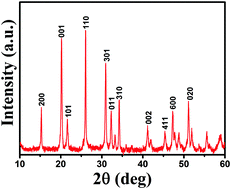V2O5 nanorod electrode material for enhanced electrochemical properties by a facile hydrothermal method for supercapacitor applications†
Abstract
Metal oxides have attracted considerable interest due to their distinguished electrochemical properties and applications in multiple fields such as supercapacitors and solar cells. It is beneficial to exploit V2O5 electrode materials with desired structures as well as potential applications due to their low-cost, low toxicity, wide voltage windows and multiple oxidation states. A facile hydrothermal method for synthesizing V2O5 nanorods using ammonium metavanadate with an acidic reducing agent at 200 °C is reported. The surface morphology, crystallinity and functional group modifications of the nanorods are analyzed by scanning electron microscopy, transmission electron microscopy, and energy dispersive X-ray analysis. V2O5 nanorods on stainless steel (SS) plate architecture exhibit an outstanding electrochemical performance in supercapacitors with high areal specific capacitance of 417.4 mF cm−2 at a scan rate of 5 mV s−1, excellent rate capability, and good cycling stability for 5000 cycles in 0.5 M sodium sulfate in comparison to the observations in 0.5 M sulfuric acid and 0.5 M KCl electrolytes. Moreover, a three electrode setup is used to scrutinize the electrochemical performance of the V2O5-nanorod electrode; it shows superior performance in terms of high areal specific capacitance, which is the highest reported value so far, and it also shows long cycling stability. Our study demonstrates that the as-fabricated V2O5 nanorods can be applied in both high energy density fields and high power density applications such as flexible electronics, electric vehicles and energy storage devices.



 Please wait while we load your content...
Please wait while we load your content...